Pt(dithiolene)-Based Colorimetric Chemosensors for Multiple Metal-Ion Sensing
Abstract
:1. Introduction
2. Materials and Methods
2.1. Materials
2.2. General Characterization
2.3. X-ray Diffraction (XRD) for Molecular Structure Analysis
2.4. Density Functional Theory (DFT) Calculations
2.5. Synthesis
2.6. Metal-ion Sensing with a Pt2+-Chemosensor
2.7. Job’s Method
3. Results
3.1. Chemistry
3.2. Colorimetric and UV-Vis Studies
3.3. Mechanism Study
3.4. Multiple-ion Sensing Ability
4. Conclusions
Author Contributions
Funding
Institutional Review Board Statement
Informed Consent Statement
Data Availability Statement
Conflicts of Interest
References
- Park, S.; Johnson, M.A. Awareness of Fish Advisories and Mercury Exposure in Women of Childbearing Age. Nutr. Rev. 2006, 64, 250–256. [Google Scholar] [CrossRef]
- Tchounwou, P.B.; Ayensu, W.K.; Ninashvili, N.; Sutton, D. Environmental exposure to mercury and its toxicopathologic implications for public health. Environ. Toxicol. 2003, 18, 149–175. [Google Scholar] [CrossRef]
- Guo, C.; Irudayaraj, J. Fluorescent Ag Clusters via a Protein-Directed Approach as a Hg(II) Ion Sensor. Anal. Chem. 2011, 83, 2883–2889. [Google Scholar] [CrossRef]
- Shunmugam, R.; Gabriel, G.J.; Smith, C.E.; Aamer, K.A.; Tew, G.N. A Highly Selective Colorimetric Aqueous Sensor for Mercury. Chem. Eur. J. 2008, 14, 3904–3907. [Google Scholar] [CrossRef]
- Fanna, D.J.; Lima, L.M.P.; Wei, G.; Li, F.; Reynolds, J.K. A colorimetric chemosensor for quantification of exchangeable Cu2+ in soil. Chemosphere 2020, 238, 124664. [Google Scholar] [CrossRef]
- Guo, X.; Qian, X.; Jia, L. A Highly Selective and Sensitive Fluorescent Chemosensor for Hg2+ in Neutral Buffer Aqueous Solution. J. Am. Chem. Soc. 2004, 126, 2272–2273. [Google Scholar] [CrossRef]
- Khan, S.A.; Ullah, Q.; Parveen, H.; Mukhtar, S.; Alzahrani, K.A.; Asad, M. Synthesis and photophysical investigation of novel imidazole derivative an efficient multimodal chemosensor for Cu(II) and fluoride ions. J. Photochem. Photobiol. A Chem. 2021, 406, 113022. [Google Scholar] [CrossRef]
- Khan, S.A.; Ullah, Q.; Almalki, A.S.A.; Kumar, S.; Obaid, R.J.; Alsharif, M.A.; Alfaifi, S.Y.; Hashmi, A.A. Synthesis and photophysical investigation of (BTHN) Schiff base as off-on Cd2+ fluorescent chemosensor and its live cell imaging. J. Mol. Liq. 2021, 328, 115407. [Google Scholar] [CrossRef]
- Asiri, A.M.; Al-Amari, M.M.; Ullah, Q.; Khan, S.A. Ultrasound-assisted synthesis and photophysical investigation of a heterocyclic alkylated chalcone: A sensitive and selective fluorescent chemosensor for Fe3+ in aqueous media. J. Coord. Chem. 2020, 73, 2987–3002. [Google Scholar] [CrossRef]
- Maiti, S.; Barman, G.; Konar Laha, J. Detection of heavy metals (Cu+2, Hg+2) by biosynthesized silver nanoparticles. Appl. Nanosci. 2016, 6, 529–538. [Google Scholar] [CrossRef] [Green Version]
- Maiti, S.; Prins, L.J. Dynamic combinatorial chemistry on a monolayer protected gold nanoparticle. Chem. Commun. 2015, 51, 5714–5716. [Google Scholar] [CrossRef]
- Maiti, S.; Prins, L.J. A modular self-assembled sensing system for heavy metal ions with tunable sensitivity and selectivity. Tetrahedron 2017, 73, 4950–4954. [Google Scholar] [CrossRef]
- Zhang, S.; Wu, X.; Niu, Q.; Guo, Z.; Li, T.; Liu, H. Highly Selective and Sensitive Colorimetric and Fluorescent Chemosensor for Rapid Detection of Ag+, Cu2+ and Hg2+ Based on a Simple Schiff Base. J. Fluoresc. 2017, 27, 729–737. [Google Scholar] [CrossRef] [PubMed]
- Jeon, H.; Suh, W.; Noh, D.-Y. Hg(II) sensing properties of (diphosphine)Pt(dmit) complexes (dmit: C3S52−: 1,3-dithiole-2-thione-4,5-dithiolate). Inorg. Chem. Commun. 2012, 24, 181–185. [Google Scholar] [CrossRef]
- Jeon, H.; Ryu, H.; Nam, I.; Noh, D.-Y. Heteroleptic Pt(II)-dithiolene-based Colorimetric Chemosensors: Selectivity Control for Hg(II) Ion Sensing. Materials 2020, 13, 1385. [Google Scholar] [CrossRef] [PubMed] [Green Version]
- Doidge-Harrison, S.M.S.V.; Irvine, J.T.S.; Khan, A.; Spencer, G.M.; Wardell, J.L.; Aupers, J.H. Diorganotin 1,3-dithiole-2-thione-4,5-dithiolate compounds, R2Sn(dmit): The crystal structure of MePhSn(dmit). J. Organomet. Chem. 1996, 516, 199–205. [Google Scholar] [CrossRef]
- Nomura, M.; Fourmigué, M. Dinuclear Cp* Cobalt Complexes of the 1,2,4,5-Benzenetetrathiolate Bischelating Ligand. Inorg. Chem. 2008, 47, 1301–1312. [Google Scholar] [CrossRef]
- Grimme, S. Semiempirical GGA-type density functional constructed with a long-range dispersion correction. J. Comput. Chem. 2006, 27, 1787–1799. [Google Scholar] [CrossRef]
- Perdew, J.P.; Burke, K.; Ernzerhof, M. Generalized Gradient Approximation Made Simple. Phys. Rev. Lett. 1996, 77, 3865–3868. [Google Scholar] [CrossRef] [Green Version]
- Kresse, G.; Furthmüller, J. Efficient iterative schemes for ab initio total-energy calculations using a plane-wave basis set. Phys. Rev. B 1996, 54, 11169–11186. [Google Scholar] [CrossRef]
- Hackett, M.; Whitesides, G.M. [Bis(dicyclohexylphosphino)ethane]platinum(0). Reactions with alkyl, (trimethylsilyl)methyl, aryl, benzyl, and alkynyl carbon-hydrogen bonds. J. Am. Chem. Soc. 1988, 110, 1449–1462. [Google Scholar] [CrossRef]
- Vicente, R.; Ribas, J.; Solans, X.; Font-Altaba, M.; Mari, A.; de Loth, P.; Cassoux, P. Electrochemical, EPR, and crystal structure studies on mixed-ligand 4,5-dimercapto-l,3-dithia-2-thione phosphine complexes of nickel, palladium and platinum, M(dmit)(dppe) and Pt(dmit)(PPh3)2. Inorg. Chim. Acta 1987, 132, 229–236. [Google Scholar] [CrossRef]
- Shin, K.-S.; Jung, Y.; Lee, S.-K.; Fourmigué, M.; Barrière, F.; Bergamini, J.-F.; Noh, D.-Y. Redox bifunctionality in a Pt(ii) dithiolene complex of a tetrathiafulvalene diphosphine ligand. Dalton Trans. 2008, 5869–5871. [Google Scholar] [CrossRef]
- Bratsch, S.G. Standard Electrode Potentials and Temperature Coefficients in Water at 298.15 K. J. Phys. Chem. Ref. Data 1989, 18. [Google Scholar] [CrossRef] [Green Version]
- Pearson, R.G. Hard and Soft Acids and Bases. J. Am. Chem. Soc. 1963, 85, 3533–3539. [Google Scholar] [CrossRef]
- Orava, J.; Jääskeläinen, T.; Parkkinen, J.; Leppanen, V.-P. Diffractive CIE 1931 chromaticity diagram. Color Res. Appl. 2007, 32, 409–413. [Google Scholar] [CrossRef]
- Agency for Toxic Substances and Disease Registry (ATSDR). Toxicological Profile for Mercury; U.S. Department of Health and Human Services, Public Health Service: Atlanta, GA, USA, 1999.
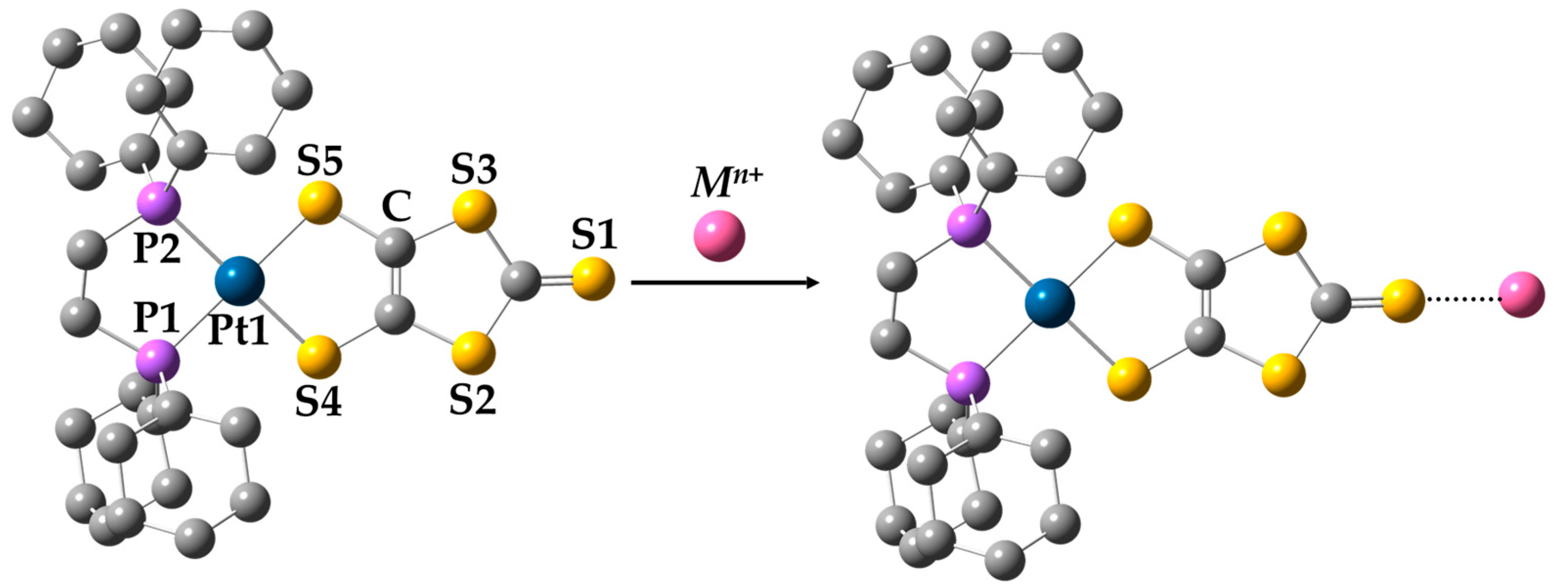

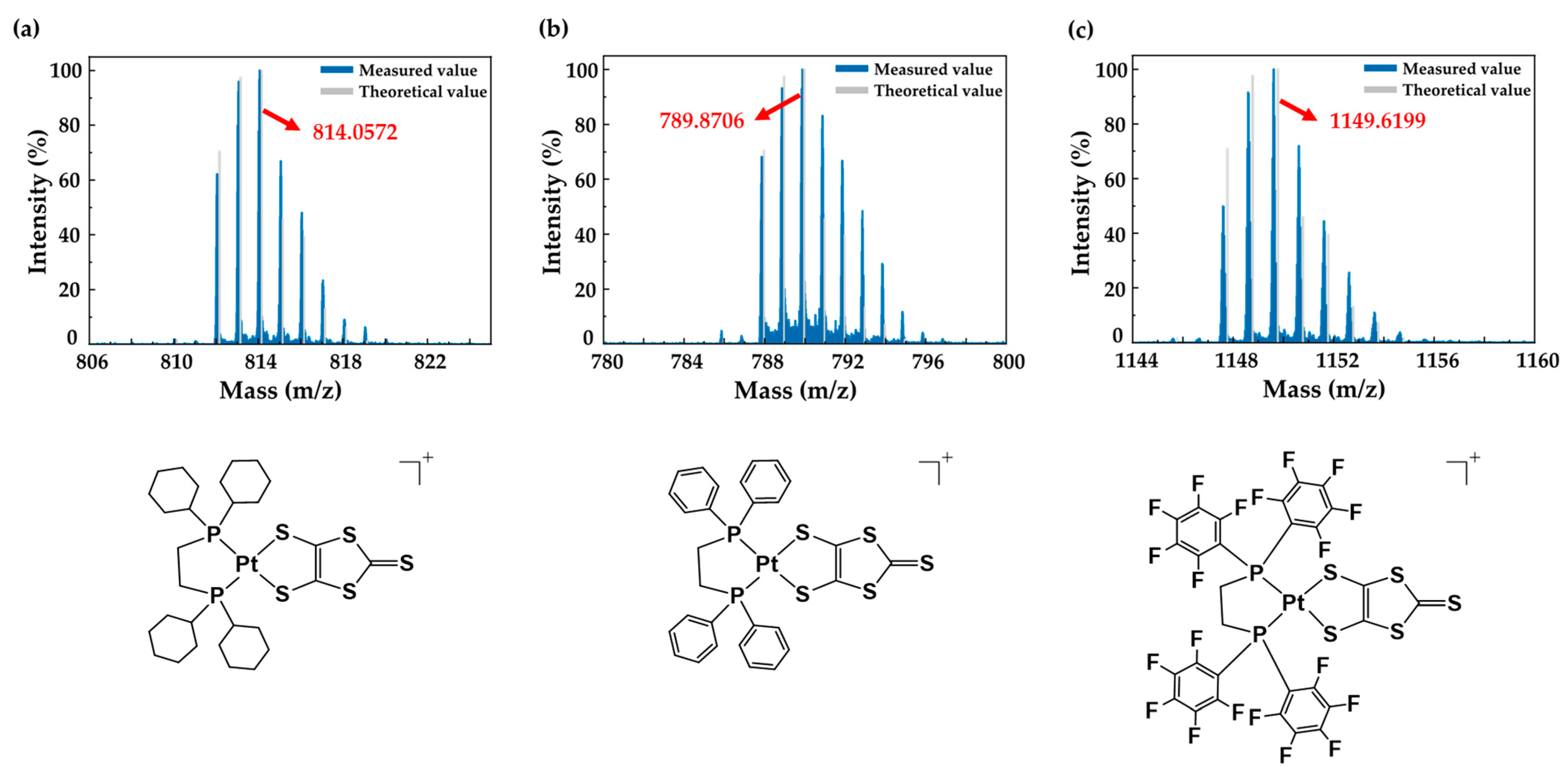


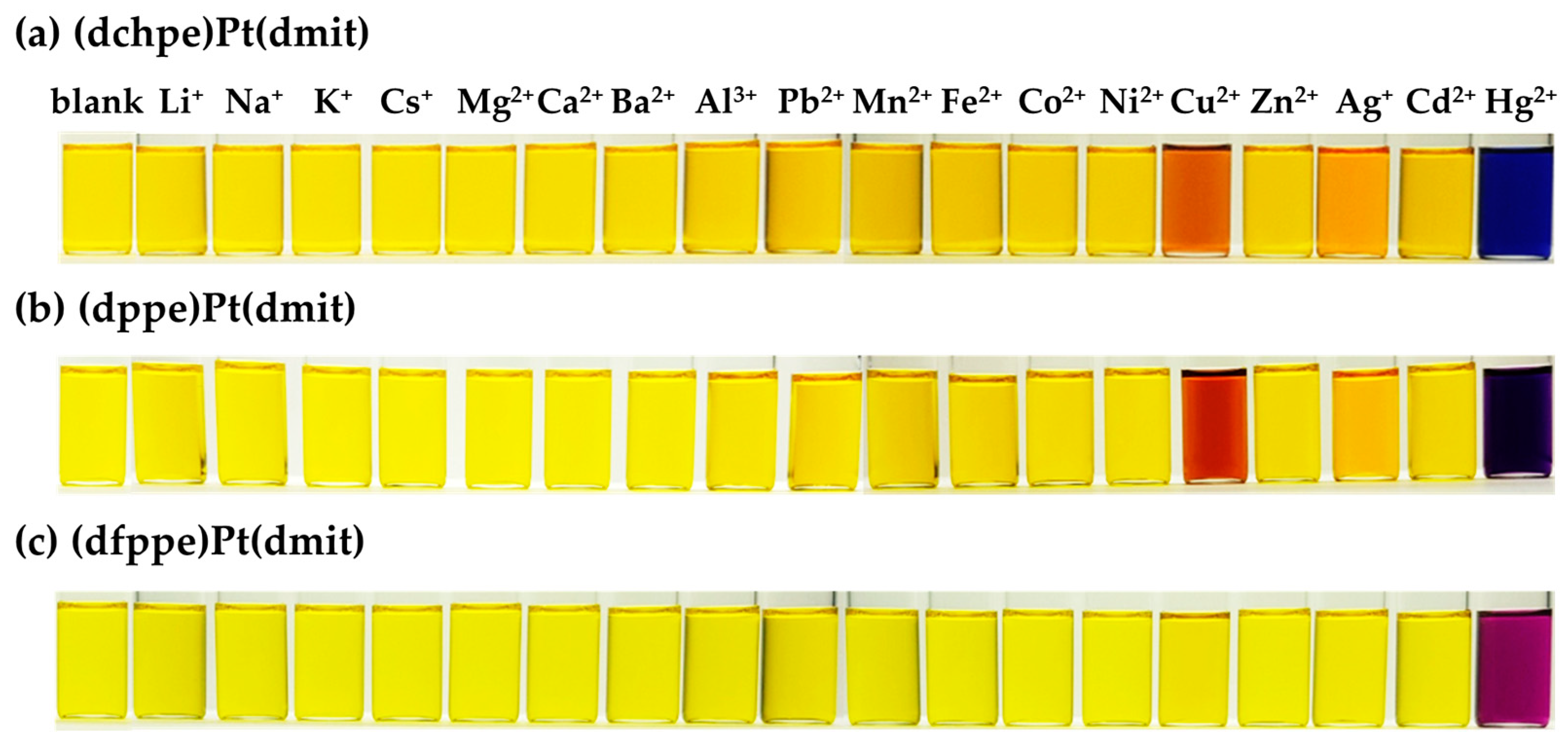



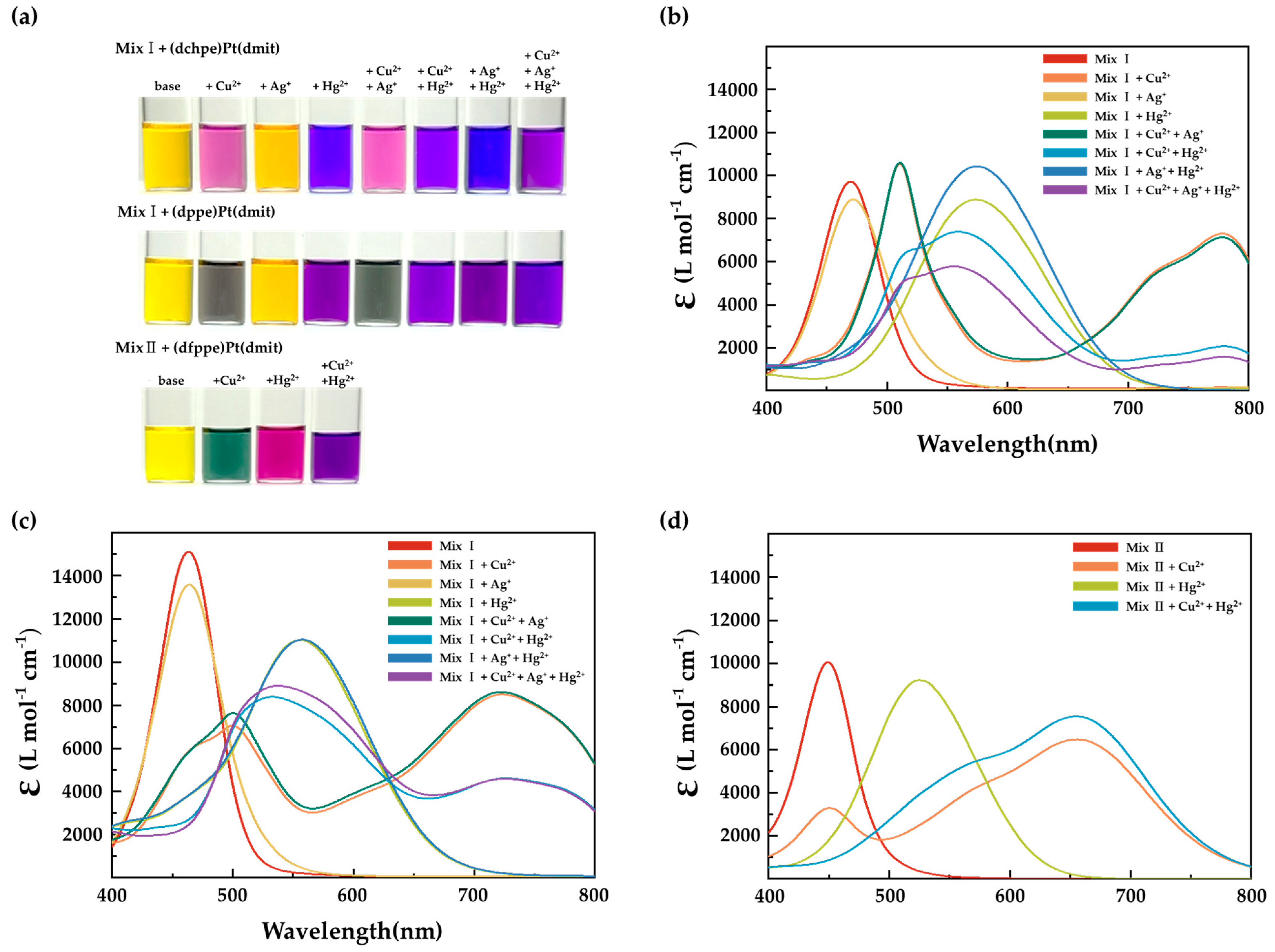
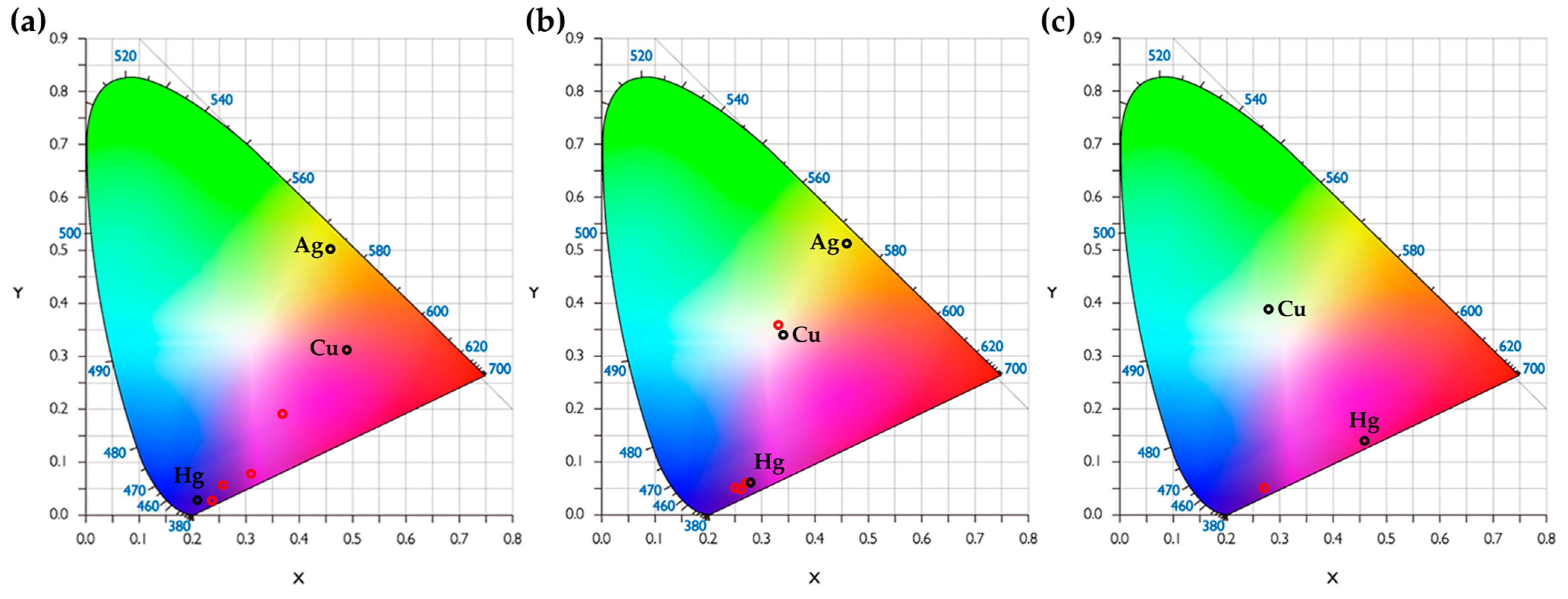
| χ 2 | 0.0 | 0.1 | 0.2 | 0.3 | 0.4 | 0.5 | 0.6 | 0.7 | 0.8 | 0.9 | 1.0 |
|---|---|---|---|---|---|---|---|---|---|---|---|
| (dxpe)Pt(dmit) | 0.00 | 0.15 | 0.30 | 0.45 | 0.60 | 0.75 | 0.90 | 1.05 | 1.20 | 1.35 | 1.50 |
| Hg2+ | 1.50 | 1.35 | 1.20 | 1.05 | 0.90 | 0.75 | 0.60 | 0.45 | 0.30 | 0.15 | 0.00 |
| Solvent 3 | 1.50 | 1.50 | 1.50 | 1.50 | 1.50 | 1.50 | 1.50 | 1.50 | 1.50 | 1.50 | 1.50 |
| Complex | Epa1 | Epa2 | Epc1 | E1/21 b |
|---|---|---|---|---|
| (dchpe)Pt(dmit) | 0.717 | 1.300 | 0.644 | 0.681 |
| (dppe)Pt(dmit) | 0.739 | 1.230 | 0.698 | 0.719 |
| (dfppe)Pt(dmit) | 0.885 | 1.650 | 0.736 | 0.811 |
| Half−Reaction | E° (V) |
|---|---|
| Hg2+(aq) + 2 e− → Hg (l) | +0.85 |
| Ag+(aq) + e− → Ag (s) | +0.80 |
| Cu2+(aq) + 2 e− → Cu (s) | +0.34 |
| 2 H+(aq) + 2 e− → H2 (g) | 0.00 |
| Pb2+(aq) + 2 e− → Pb (s) | −0.13 |
| Ni2+(aq) + 2 e− → Ni (s) | −0.25 |
| Co2+(aq) + 2 e− → Co (s) | −0.28 |
| Cd2+(aq) + 2 e− → Cd (s) | −0.40 |
| Fe2+(aq) + 2 e− → Fe (s) | −0.44 |
| Zn2+(aq) + 2 e− → Zn (s) | −0.76 |
| Mn2+(aq) + 2 e− → Mn (s) | −1.18 |
| Al3+(aq) + 3 e− → Al (s) | −1.66 |
| Mg2+(aq) + 2 e− → Mg (s) | −2.37 |
| Na+(aq) + e− → Na (s) | −2.71 |
| Ca2+(aq) + 2 e− → Ca (s) | −2.87 |
| Ba2+(aq) + 2 e− → Ba (s) | −2.90 |
| K+(aq) + e− → K (s) | −2.93 |
| Cs+(aq) + e− → Cs (s) | −3.03 |
| Li+(aq) + e− → Li (s) | −3.04 |
| Complex | Δ(−e) (1) | |||
|---|---|---|---|---|
| Hg2+ | Cu2+ | Ag+ | Na+ | |
| (dchpe)Pt(dmit) | −1.71 | −1.52 | −0.61 | −0.10 |
Publisher’s Note: MDPI stays neutral with regard to jurisdictional claims in published maps and institutional affiliations. |
© 2021 by the authors. Licensee MDPI, Basel, Switzerland. This article is an open access article distributed under the terms and conditions of the Creative Commons Attribution (CC BY) license (https://creativecommons.org/licenses/by/4.0/).
Share and Cite
Son, H.; Jang, S.; Lim, G.; Kim, T.; Nam, I.; Noh, D.-Y. Pt(dithiolene)-Based Colorimetric Chemosensors for Multiple Metal-Ion Sensing. Sustainability 2021, 13, 8160. https://doi.org/10.3390/su13158160
Son H, Jang S, Lim G, Kim T, Nam I, Noh D-Y. Pt(dithiolene)-Based Colorimetric Chemosensors for Multiple Metal-Ion Sensing. Sustainability. 2021; 13(15):8160. https://doi.org/10.3390/su13158160
Chicago/Turabian StyleSon, Heawon, Seohyeon Jang, Gayoung Lim, Taeyong Kim, Inho Nam, and Dong-Youn Noh. 2021. "Pt(dithiolene)-Based Colorimetric Chemosensors for Multiple Metal-Ion Sensing" Sustainability 13, no. 15: 8160. https://doi.org/10.3390/su13158160
APA StyleSon, H., Jang, S., Lim, G., Kim, T., Nam, I., & Noh, D.-Y. (2021). Pt(dithiolene)-Based Colorimetric Chemosensors for Multiple Metal-Ion Sensing. Sustainability, 13(15), 8160. https://doi.org/10.3390/su13158160






